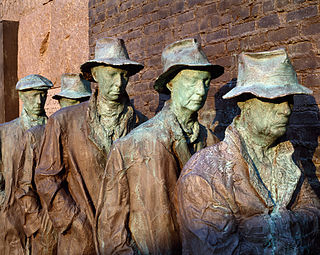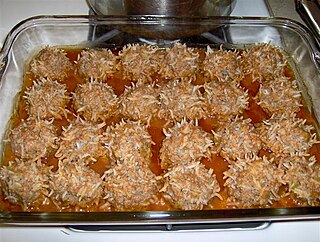 W
WIn the United States, the Great Depression began with the Wall Street Crash of October 1929. The stock market crash marked the beginning of a decade of high unemployment, poverty, low profits, deflation, plunging farm incomes, and lost opportunities for economic growth as well as for personal advancement. Altogether, there was a general loss of confidence in the economic future.
 W
WThe Bank of United States, founded by Joseph S. Marcus in 1913 at 77 Delancey Street in New York City, was a New York City bank that failed in 1931. The bank run on its Bronx branch is said to have started the collapse of banking during the Great Depression.
 W
WThe Bonus Army was a group of 43,000 demonstrators – made up of 17,000 U.S. World War I veterans, together with their families and affiliated groups – who gathered in Washington, D.C. in mid-1932 to demand early cash redemption of their service bonus certificates. Organizers called the demonstrators the "Bonus Expeditionary Force", to echo the name of World War I's American Expeditionary Forces, while the media referred to them as the "Bonus Army" or "Bonus Marchers". The demonstrators were led by Walter W. Waters, a former sergeant.
 W
WThe Cotton-Holiday was a 1931 proposal by Louisiana Governor and US Senator-elect Huey Long to alleviate an oversurplus of cotton. The holiday would have banned cotton production in 1932, decreasing supply and raising prices. It has been credited as the first suggestion of artificial scarcity as a solution to the Great Depression.
 W
WThe Dust Bowl was a period of severe dust storms that greatly damaged the ecology and agriculture of the American and Canadian prairies during the 1930s; severe drought and a failure to apply dryland farming methods to prevent the aeolian processes caused the phenomenon. The drought came in three waves: 1934, 1936, and 1939–1940, but some regions of the High Plains experienced drought conditions for as many as eight years.
 W
WDust pneumonia describes disorders caused by excessive exposure to dust storms, particularly during the Dust Bowl in the United States. A form of pneumonia, dust pneumonia results when the lungs are filled with dust, inflaming the alveoli.
 W
WIn 1939, President Franklin D. Roosevelt moved the Thanksgiving holiday one week earlier than normal, believing that doing so would help bolster retail sales during one of the final years of the Great Depression. This led to much upheaval and protest, causing some to deride the holiday as Franksgiving. The term Franksgiving is a portmanteau of Franklin and Thanksgiving and was coined by Atlantic City mayor Charles D. White in 1939. In 1941, Congress compromised by fixing Thanksgiving on the fourth Thursday of November.
 W
WA hobo stove is a style of improvised heat-producing and cooking device used in survival situations, by backpackers, hobos, tramps and homeless people. Hobo stoves can be functional to boil water for purification purposes during a power outage and in other survival situations, and can be used for outdoor cooking.
 W
WA "Hooverville" was a shanty town built during the Great Depression by the homeless in the United States. They were named after Herbert Hoover, who was President of the United States during the onset of the Depression and was widely blamed for it. The term was coined by Charles Michelson, publicity chief of the Democratic National Committee. There were hundreds of Hoovervilles across the country during the 30s.
 W
WAndrew William Mellon, sometimes A.W., was an American banker, businessman, industrialist, philanthropist, art collector, and politician. From the wealthy Mellon family of Pittsburgh, Pennsylvania, he established a vast business empire before moving into politics. He served as United States Secretary of the Treasury from March 9, 1921, to February 12, 1932, presiding over the boom years of the 1920s and the Wall Street crash of 1929. A conservative Republican, Mellon favored policies that reduced taxation and the national debt in the aftermath of World War I.
 W
WThe Navajo Livestock Reduction was imposed by the United States government upon the Navajo Nation in the 1930s, during the Great Depression. The reduction of herds was justified at the time by stating that grazing areas were becoming eroded and deteriorated due to too many animals.
 W
WThe Palace of Depression was a building made of junk that was located in Vineland, New Jersey, built by the eccentric and mustachioed George Daynor, a former Alaska gold miner who lost his fortune in the Wall Street Crash of 1929. This amusement was known as "The Strangest House in the World" and the "Home of Junk" and was built as a testament of willpower against the effects of The Great Depression.
 W
WA pea-picker is a derogatory reference to poor, migrant workers during the Great Depression. These people were unskilled, poorly educated workers, employable only in menial jobs, such as harvesting crops and, as such, received poor wages for working long hours under dreadful conditions. Some of these people were photographed by Dorothea Lange.
 W
WThe Pecora Investigation was an inquiry begun on March 4, 1932, by the United States Senate Committee on Banking and Currency to investigate the causes of the Wall Street Crash of 1929. The name refers to the fourth and final chief counsel for the investigation, Ferdinand Pecora. His exposure of abusive practices in the financial industry galvanized broad public support for stricter regulations. As a result, the U.S. Congress passed the Glass–Steagall Banking Act of 1933, the Securities Act of 1933, and the Securities Exchange Act of 1934.
 W
WA penny auction is a collective action taken during the auction of a foreclosed property to force the sale of the property at a low price, with the intent of then returning the property to its previous owner. The process—usually achieved with a combination of intimidation, threats, and physical force—effectively circumvents foreclosure by forcing the lender to relinquish the property without an opportunity to recuperate the balance of the loan.
 W
WPorcupine meatballs are an American dish of ground beef and rice meatballs cooked in tomato sauce. They were a staple during the Great Depression requiring only a few basic ingredients: ground beef, uncooked long-grain rice, onion, and canned tomato soup. The name comes from the appearance of the meatballs, which appear prickly when the rice pokes out of them as they cook, resembling a porcupine.
 W
WProhibition in the United States was a nationwide constitutional ban on the production, importation, transportation, and sale of alcoholic beverages from 1920 to 1933.
 W
WThe recession of 1937–1938 was an economic downturn that occurred during the Great Depression in the United States.
 W
WThe Tariff Act of 1930, commonly known as the Smoot–Hawley Tariff or Hawley–Smoot Tariff, was a law that implemented protectionist trade policies in the United States. Sponsored by Senator Reed Smoot and Representative Willis C. Hawley, it was signed by President Herbert Hoover on June 17, 1930. The act raised US tariffs on over 20,000 imported goods.
 W
WFlorence Owens Thompson was an American woman who was the subject of Dorothea Lange's photograph Migrant Mother (1936), considered an iconic image of the Great Depression. The Library of Congress titled the image: "Destitute pea pickers in California. Mother of seven children. Age thirty-two. Nipomo, California."
 W
WThe Wall Street Crash of 1929, also known as the Great Crash, was a major American stock market crash that occurred in the autumn of 1929. It started in September and ended late in October, when share prices on the New York Stock Exchange collapsed.
 W
WWeedpatch Camp was built by the Works Progress Administration (WPA) south of Bakersfield, California, in 1936 to house migrant workers during the Great Depression. Several historic buildings at the camp were placed on the National Register of Historic Places (NRHP) on January 22, 1996.
 W
WIn the United States, a wooden nickel is a wooden token coin, usually issued by a merchant or bank as a promotion, sometimes redeemable for a specific item such as a drink.
 W
WThe Works Progress Administration was an American New Deal agency, employing millions of jobseekers to carry out public works projects, including the construction of public buildings and roads. It was set up on May 6, 1935, by presidential order, as a key part of the Second New Deal.